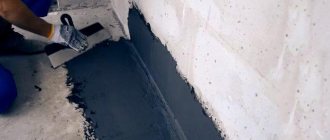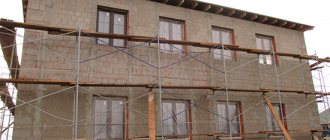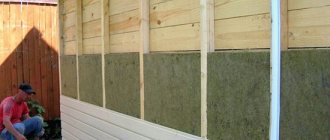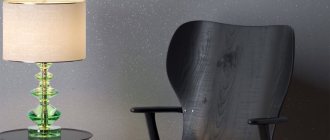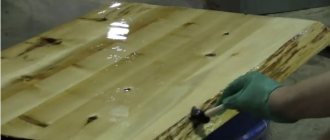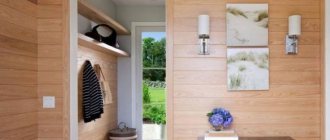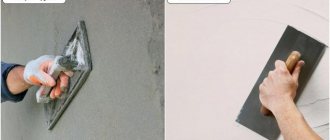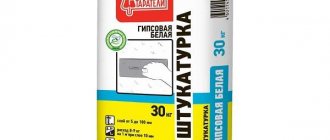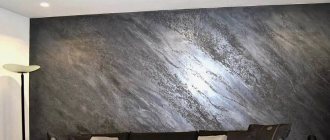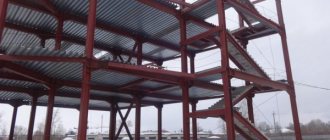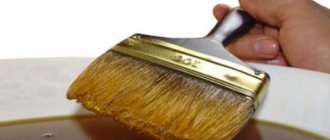In private and public premises it is often necessary to reduce the noise level. Soundproofing plaster helps solve this problem. The cost is acceptable, from an environmental point of view it does not pose any danger, and can be applied to the surface without any problems. Noise absorption properties are achieved thanks to the porous structure of the material, which includes light granules of fillers in the form of pumice, expanded clay stone, vermiculite, fractions in size do not exceed 5 mm. The density of such plaster is low, but the porosity and looseness of the structure contribute to the absorption of noise.
Peculiarities
The modern building materials market offers the buyer a huge number of finishing options with soundproofing characteristics. Such coatings include a special type of plaster composition.
High-quality material, applied according to the instructions, absorbs about 50% of extraneous sounds arising behind the walls of the room.
Soundproofing plaster, unlike most options for soundproofing coatings, when applied to the wall surface, looks uniform and does not form joining areas, creating a good sound absorption rate. When finishing, remember that the plaster layer is not covered with high-density paints and varnishes and is not covered with wallpaper. Otherwise, the noise insulation rate will be extremely low. Adhesive composition and thick paint will clog the pores of the surface, worsening the noise-absorbing properties of the finishing material.
Drywall
To create reliable sound insulation, you need to choose a material of high density. Drywall, designed to suppress sound vibrations, contains special membranes and mineral wool. To enhance the sound insulation effect, many sheets should be laid. To make a sound-absorbing structure, you need to use 2 sheets of gypsum plasterboard or use a combination of gypsum plasterboard + gypsum plasterboard.
Drywall can withstand significant loads. It is fire resistant and not susceptible to moisture. The material can be formed and does not crumble. For high-quality insulation, exclusively dense plasterboard is used.
Soundproofing methods
Perhaps at least half of the population is faced with problematic issues related to troubled neighbors, highway noise, etc. For these reasons, wall materials have appeared that help reduce extraneous noise. Each has different features, so it is best to consider them separately.
Styrofoam
This material is used for the following reasons:
- the cost is low, the work associated with its installation is carried out with minimal financial costs;
- this type of soundproofing of walls in a room under a plaster or other finishing layer is easy to implement;
- the material is available and sold in every hardware store;
- low weight simplifies loading and unloading, transportation and installation;
- minimal load is created on the walls.
Unfortunately, polystyrene foam has a number of negative aspects:
- The sound suppression rate is weak. Naturally, there will be a certain soundproofing effect, but it is low compared to other finishing options;
- using polystyrene foam, you will have to incur additional costs associated with finishing in order to strengthen the surface with mortar or decorative material.
Drywall
It's no secret that finishing with such material is a popular option today. With its help, you can independently implement unusual design ideas.
When purchasing drywall, you also need to buy acoustic insulation material. It is sold in rolls, from which pieces are cut to the required sizes.
Please note that such insulation must have acoustic properties (the manufacturer indicates these parameters on the packaging material).
The soundproofing material is located inside the frame base; it is recommended to lay it as tightly as possible. You should not forget about the air gap that will have to be created between the walls and the material. It will help improve sound insulation performance and remove excess moisture.
This material is affordable and easy to install.
Soundproofing boards
This group of materials has the following properties:
- high performance indicators that can provide good acoustic properties;
- Mineralized wool is used in the manufacture of such slabs. It does not cause harm to the human body and can be used for interior work in residential premises;
- The material is durable and easy to handle, installation work is carried out with good quality.
Despite all the advantages, it should be noted that such material is quite expensive, and for this reason it is not particularly popular among private owners. In most cases, it is used for finishing studio rooms and other public buildings. In addition, to ensure a high sound-absorbing level, all work must be carried out in strict accordance with the technological map, which is not always possible.
Acoustic insulation (mat)
The material has good soundproofing capabilities, reasonable cost, and ease of installation. Sold in rolls, can be cut into pieces of required sizes.
Recommended for use when finishing walls with plasterboard sheets; it is laid in a frame. When purchasing such material, you need to check whether it has different acoustic capabilities.
Soundproofing plaster
This finishing option is the most popular for certain reasons:
- its cost is very reasonable, the work can be done on your own;
- its use not only solves a number of problematic issues, but also saves time - the coating does not require additional finishing;
- the composition does not create harm to the human body and is intended for finishing any premises;
- Soundproofing plaster for walls will not only provide protection from extraneous noise, but will also perfectly insulate external walls.
This option is superior to other materials in terms of sound retention by almost 35%. This is explained by the fact that on the surface finished with plaster mortar there are no seam areas through which sound can penetrate.
From all that has been said, it becomes clear that you can use any of the convenient methods. But if you are pursuing the goal of maximum protection from extraneous sounds, then it is recommended to use soundproofing plaster. There are several more reasons why it is preferred:
- all work can be completed independently and in a short time;
- the surface of the walls does not have to be pre-leveled and prepared;
- the plaster is not susceptible to insects and small rodents;
- It can be applied manually and with special installations.
The material really protects against extraneous noise better than others, and it is rightly called acoustic plaster.
Noise and vibration protection
| HOME | | | COMPANY | | | MATERIALS | | | SERVICES | | | PRICES | | | OBJECTS | | | ARTICLES | | | FORUM | | | CONTACTS |
- Soundproofing
- Vibration isolation
- Room acoustics
- Directory
- About company
- Patents and trademarks
- our clients
- News
- Sound insulation All materials
- Soundproofing mounts
- Acoustic mineral wool AcousticWool Sonet P
- Acoustic Wool Sonet
- AcousticWool Sonet F
- Acoustic Wool Eco
- Vibrosil Tape
- Vibrostop
- Vibration isolating material Sylomer
- all materials
- Acoustic services
- Construction services
- Waterjet cutting
- Prices
- Where can I buy?
Effective sound insulation. Basic Rules
Sound insulation - attenuation of sound as it penetrates through the fences of buildings; in a broader sense - a set of measures to reduce the level of noise entering premises from the outside. The quantitative measure of sound insulation of building envelopes, expressed in decibels (dB), is called sound insulation capacity. A distinction is made between airborne and impact sound insulation.
Architectural aspects
1. Sound insulation begins with an architectural and planning solution! This means that the soundproofed room must be located as far as possible from sources of noise and vibration (elevator shaft, garbage chute, ventilation chamber, bathrooms, etc.) not only horizontally, but also vertically of the building. The closer the source is, the more difficult and expensive subsequent soundproofing measures will be. In some cases, the location of powerful noise sources in close proximity to the protected premises leads to the impossibility of using these premises for their intended purpose and their subsequent repurposing.
Soundproofing walls
2. Soundproofing structures must be airtight. Sound insulation does not tolerate cracks and holes, just like the hull of a boat launched into the water. Be sure to seal all cracks and leaks in the fences (places for installing electrical accessories, heating risers, joints between floor panels and walls, etc.) with non-hardening silicone sealant. Do not use polyurethane foam to seal holes without subsequent plastering. Polyurethane foam is not a soundproofing material and, in addition, is highly flammable.
3. If possible, increase the weight of the fences. The more massive the fence, the more energy the sound will need to “shake” it and the less sound will be re-radiated into the adjacent room. If the partition is made using frame plasterboard technology, then increase the number of layers of plasterboard. This is the easiest and cheapest way to increase weight. But if the load-bearing capacity of the floor allows, it is much more effective to build a massive wall of solid red brick. A very effective design for isolating a powerful musical signal is a wall made of hollow concrete (cinder concrete) blocks with preliminary filling of the voids with calcined dry sand.
4. Double walls are preferable to single structures. This also applies to fences made of massive materials and frame structures. Acoustic decoupling, or the physical elimination of rigid connections between double walls, radically reduces the transmission of noise and vibration from one side of a double wall to the other. The sound insulation of a double brick wall (125 mm brick - air gap - 125 mm brick) is always higher than that of a single-layer 250 mm brick wall. The sound insulation of a gypsum plasterboard frame partition on two independent 2x50 mm frames is always higher than that of a partition on one 100 mm frame.
6. Never unnecessarily reduce the total number of layers of plasterboard partition cladding. Sound insulation increases if you use cladding made from materials with different hardness, for example, cladding with a total thickness of 25 mm and a gypsum plasterboard composition of 15mm+9.5mm is more preferable compared to gypsum plasterboard cladding 12.5mm+12.5mm. The use of a layer of viscoelastic material between the gypsum plasterboard sheets makes it possible to dampen unwanted resonances, which reduce the sound insulation of the partition at medium and high frequencies.
7. Higher sound insulation for frame partitions lined with massive but flexible sheet materials. Therefore, the use of plasterboard sheets with increased density and lower rigidity (GVL, Knauf Piano, Diamant, Silentboard) in cladding is preferable to the use of standard plasterboard boards with the same thickness.
8. Make connections between the facings and frame elements as less rigid as possible. This can be achieved by using elastic gaskets between the gypsum board cladding and the metal frame profiles.
9. Frame partitions with two gypsum plasterboard linings have higher sound insulation compared to partitions with three gypsum plasterboard linings (with the same total thickness of the partition and the same total thickness of the gypsum plasterboard layers). To ensure high sound insulation at low frequencies, never build partitions with three facings!
10. The actual sound insulation of the fence is not proportional to the value of the airborne noise insulation index Rw. The Rw index is an integral characteristic, used only for the frequency range 100-3150 Hz and designed to assess noise of everyday origin (spoken speech, radio, TV). The method for calculating the Rw index does not take into account the presence of powerful low-frequency sources in modern residential buildings: home theaters, noisy engineering equipment (fans, air conditioners, pumps, etc.). A situation is possible when a light frame partition made of gypsum plasterboard has an Rw index higher than that of a brick wall of the same thickness. In this case, a frame partition isolates the sounds of a voice, a running TV, a ringing phone or an alarm clock much better, but a brick wall will more effectively reduce the sound of a home theater subwoofer. Before constructing partitions, analyze the frequency characteristics of existing or potential noise sources. When choosing design options for partitions, it is recommended to compare their sound insulation in third-octave frequency bands, rather than Rw indices.
11. Additional sound insulation of a massive partition (brick, concrete, foam concrete, gypsum blocks, etc.), made using plasterboard cladding, is increased if the cladding frame is secured to the wall using special soundproofing fasteners Vibrofix or similar, and not using conventional ones U-shaped brackets. The use of elastic fasteners with a low resonant frequency leads to high sound insulation rates at low frequencies.
13. To increase the sound insulation of plasterboard partitions (wall claddings) it is necessary:
-build plasterboard partitions on independent double frames; - install soundproof wall cladding using soundproofing elastic fasteners; -increase the thickness of the structure as much as possible (the distance between the cladding or the cladding and the wall); -increase the distance between the rack profiles as much as possible; -increase the surface mass of the cladding; -use cladding made of massive but flexible sheet materials; -fill the frame with special acoustic mineral wool to its full depth; - use layers of viscoelastic materials as part of the cladding; - secure partitions (wall cladding) to the floor and ceiling using soundproofing profiles.
14. The sound insulation of walls with windows or doors is practically determined by the sound insulation of the openings, which is usually lower than the sound insulation of the blind part of the fence. Focus your efforts on increasing the sound insulation of windows and doors. And then choose a partition design with adequate sound insulation ability.
15. Always pay attention to the insulation of indirect paths of sound propagation through adjacent building structures, heating and water supply pipelines, transit ventilation ducts, and the common space of a suspended ceiling or floor on joists for adjacent rooms.
Soundproofing the floor
16. The use of a floating floor (screed - elastic layer - ceiling) always leads to an increase in impact noise insulation "from top to bottom". Do not attempt to construct a floating floor yourself. By using a well-known design, but untested or unsuitable materials for a particular application, it is very easy to “tune” a floating floor to an undesirable resonant frequency. Thus, despite great efforts and financial costs, it is possible not only not to increase, but even to worsen the sound insulation of the floor at some frequencies. The resonant frequency of a properly designed floating floor should be well below 100 Hz.
17. To increase the sound insulation of a floating floor with a concrete screed, you must:
-increase the surface mass of the screed; -use a soundproofing layer with a low dynamic stiffness value; -increase the thickness of the insulating layer; - separate the screed from the side surfaces of the walls with elastic spacers.
It must be remembered that the use of a softer insulating layer material increases the efficiency of the floating floor, but reduces the stability and strength of the screed structure. Therefore, it is recommended to use slabs of acoustic mineral wool with a density of 90-140 kg/cub.m. as an insulating layer.
18. To increase the sound insulation of a floating floor on joists, you must:
-increase the surface mass of the wooden flooring; -mount logs using elastic supports with a low resonant frequency; -increase the height of the logs as much as possible; -fill the space between the joists with acoustic mineral wool; -separate the flooring from the side surfaces of the walls with elastic gaskets.
Ceiling soundproofing
19. As a rule, to increase the sound insulation of interfloor ceilings, soundproof suspended ceilings are used, which are made using frame technology and lined with plasterboard sheets.
To increase the sound insulation of a suspended ceiling, you must:
- secure the suspended ceiling frame using soundproofing fasteners with a low resonant frequency; -increase the distance between the suspended ceiling lining and the ceiling as much as possible; -increase the surface mass of the cladding; -use cladding made of massive but flexible sheet materials; -fill the frame with special acoustic mineral wool; - use layers of viscoelastic materials as part of the cladding; - ensure the connection of the suspended ceiling frame elements to the side surfaces of the walls through elastic gaskets.
Applying acoustic plaster to walls: stages
The technology for applying soundproofing mortar is practically no different from working with other plaster compounds. But there are some features that must be observed so as not to spoil the coating and reduce the level of noise absorption.
The algorithm of actions is as follows:
- any surface needs even minimal preliminary preparation. In our case, we will have to remove all dirty and greasy stains, dust from the wall, and repair chips and cracks with cement mortar in order to reduce the degree of sound conductivity;
- As soon as the wall is completely dry, a deep penetration primer is applied to it. With its help, adhesion improves;
- To increase the soundproofing effect, a mesh made of metal material can be attached to the wall surface. With its help, a layer of air is created that dampens possible sound vibrations;
- the difference in working with such a solution and simple plaster is that there is no need to use beacons - they will conduct sounds;
- to achieve a good result, apply the plaster solution in a layer of two to three centimeters. Since it is forbidden to create such a thickness at a time, you will have to plaster 10 mm at a time, but the wall will dry evenly, and the risk of cracks will be minimized. Each subsequent layer is applied after the previous one has dried completely;
- the surface is leveled as a rule, the excess mixture is removed with a polisher. Beginners are advised to use small tools to gain the necessary dexterity;
- gypsum compounds are rubbed down with a block of sandpaper, which perfectly polishes the surface. To work with cement compositions, you can use a foam float;
- All that remains is to create the finishing coating, following your own preferences - apply a layer of decorative plaster or paint the surface.
Combined method
There is another way to increase the level of sound insulation in a room - a combined method. The bottom line is that during work two types of materials are used - a solution of acoustic plaster and polystyrene foam.
The surface of the walls is first of all covered with foam plastic sheets, the thickness of which is 20 mm, after which a plaster composition is applied, which has soundproofing qualities. The absorption of sounds passing through materials with different densities is much stronger than in the case of a uniform coating. It is recommended to strictly follow the instructions for mixing soundproofing plaster mortar, since the slightest deviations can have a significant impact on the final quality of the finish.
General concepts
Sound refers to mechanical vibrations from 20 to 20,000 Hz. The human ear cannot hear frequencies higher or lower. An unwanted sound that interferes with concentration or relaxation is what we call noise.
Soundproofing, or otherwise acoustic plaster, refers to special types of protective finishing coatings.
The selection of its structural composition is based on the use of physical laws of propagation of wave oscillations in an inhomogeneous medium. To describe this in detail, you need to outline entire sections of acoustics.
In practice, it is usually sufficient to know that soundproofing plaster is saturated with tiny pores, and 2/3 of it itself consists of granules of substances that do not transmit mechanical vibrations well. Fiber materials are also added to some compositions to increase sound-damping properties. The result is a porous substance in which sound vibrations are intensively attenuated or reflected.
Types of plaster compositions
The differences between all soundproofing mixtures lie in the initial composition, which includes:
- a base represented by cement mortar, lime or gypsum;
- polymers;
- filling components.
The quality of the plaster layer and sound insulation capabilities depend on the composition of the solution. Sometimes aluminum powder is used in the manufacture of such material. This element improves the porosity of the coating, which increases the ability to absorb noise.
Surface preparation
- Remove from the walls all flaking, weakly adhering building materials; if this is not done, they will fall off during operation along with the plaster. Clean off oil and rust stains so that they do not appear on the surface. Cracks and depressions are filled with cement mortar.
- For better adhesion of the surface with the plaster mortar, apply a primer in 2 layers. The next layer is applied after the previous one has dried.
- To increase the sound absorption capacity, a metal mesh with 10 x 10 mm cells is mounted on the wall.
The mesh creates an air gap that will prevent the passage of noise.
The quality of the base coating directly depends on how correctly the walls are prepared.
Scope of use
Soundproofing plaster solutions are used for finishing rooms with high noise levels. In catering establishments (restaurant halls, cafes) it is necessary to create noise protection in order to make the rest of visitors comfortable. After all, such establishments are often located along busy streets or near roadways.
Such plaster compositions are often used in cinema halls so that extraneous noise does not interfere with watching films. In addition, this material is often used when finishing the following objects:
- offices;
- conference rooms and business centers;
- reading rooms and libraries;
- administrative buildings;
- courtrooms;
- residential and industrial premises.
To decorate premises intended for living, gypsum plaster is often used. This material is capable of creating an aesthetic coating that does not need to be covered with a finishing layer.
Selection of materials
- Compositions for the installation of soundproof plaster come to the market in the form of powder mixtures. Packing: regular paper bags.
- Like any plaster mixtures, their shelf life is limited, so when purchasing material, pay attention to the date of manufacture.
- Mixtures include granules of expanded clay, pumice, other porous stone materials, fiber from synthetic and natural fibers.
- Some manufacturers use gas-forming additives, usually based on aluminum powder. When the plaster composition is dissolved with water, aluminum oxidizes, releasing carbon dioxide, saturating the thickness of the plaster with tiny pores.
- Such mixtures are much more expensive, but their sound protection is on average 7-10% higher.
- Even before choosing a mixture, you need to determine on the basis of what binder it should be made. Gypsum-based compositions are not used for exterior decoration or for rooms with high humidity.
When choosing, pay special attention to fakes. It is best to purchase mixtures in large construction markets; do not be tempted by the low price and buy the goods second-hand.
Famous manufacturers
A very important feature is to choose the right mixture of good quality. We recommend that you familiarize yourself with popular manufacturers today:
- PL Group produces materials under the PALADIUM brand. The quality of the product is not inferior to foreign analogues. Soundproofing plaster mortar is made on the basis of foam glass. In addition to the ability to absorb sounds, the composition has thermal insulation characteristics, is considered environmentally friendly and resistant to fire. The plaster solution is suitable for finishing internal and external surfaces, forms a coating that can last at least ten years without changing its original qualities;
- IVSIL is a company that produces high-quality materials using modern technologies. The cost of building materials is acceptable; they are used for industrial and private construction. Soundproofing plaster material is made on a cement base, with the addition of polymer components and fillers. The material has thermal insulation characteristics and is non-flammable;
- Favorit is one of the largest Russian companies producing finishing materials. Sound and heat insulation mixtures produced under the DeLux brand are intended for finishing interior and exterior walls. The material is resistant to water and is used for finishing bathrooms and kitchens;
- Knauf is a well-known manufacturer of building materials. For noise-absorbing plaster, a gypsum base is used, to which mineral components are added. The material does not pose a danger to the human body because it does not contain toxins.
Preparation of the solution
Work on applying plaster is carried out at temperatures from +16 to +26 degrees and relative air humidity of 60-75%.
Prepare a container with a volume of more than 30 liters, pour dry ingredients into it. They can be purchased ready-made at a hardware store or prepared independently from cement and sand with the addition of fillers.
When preparing a solution with your own hands, cement is mixed with sand in a ratio of 1:2 or 1:3. Add 10% lime. To increase strength and density, add 2% hardener to the composition.
To increase the porosity of the coating, aluminum powder is added to the composition. To add viscosity and better adhesion to the surface, lime paste is added to the solution.
Pour the dry ingredients with water at room temperature at a rate of 9-12 liters per bag of dry powder. Mix by hand or with a construction mixer until a homogeneous mass is obtained. Leave for 5-8 minutes and mix again. The solution must be free of lumps, all components must form a single whole.
Prepare a volume of solution that is consumed within 4 hours; you need to have time to use it before the mixture thickens. The solution is not suitable for reuse.
Properties
It is made on the basis of high-quality cement, foam glass granules, fractionated sand and a complex of modifying additives. Allows you to combine the processes of plastering and improving the heat and sound insulation of walls of buildings for various purposes. The plaster is economical in consumption and is easy to apply and level. The finished surface of the leveling layer can serve as decorative plaster of the “fur coat” type with further painting of the resulting surface. De Luxe Teplolux has a low specific gravity, low thermal conductivity, as well as good vapor permeability, moisture resistance and adhesion, which guarantees the durability of the final coating. The mixture is non-flammable and fireproof. Environmentally friendly product.
